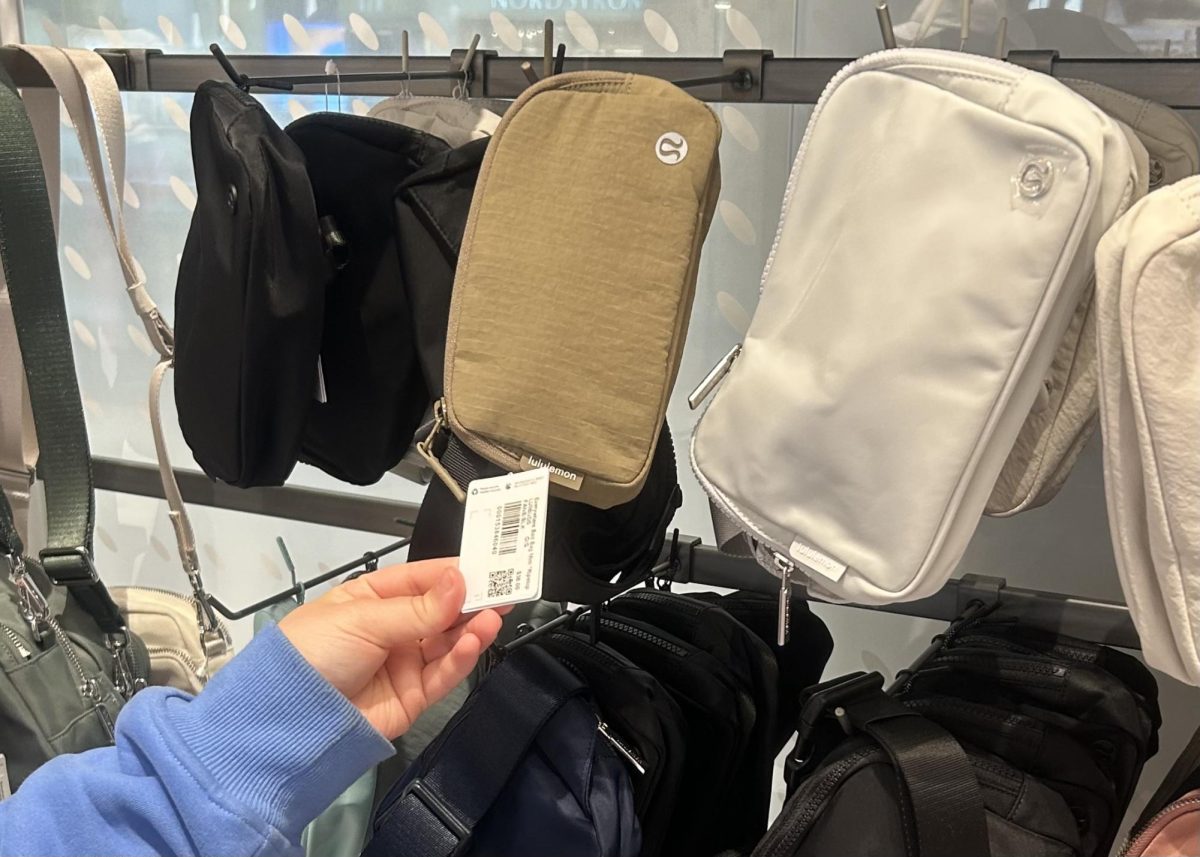These days, it seems like everyone wears some form of activewear in their daily wardrobe. But one fashion giant stands out beyond the rest: the highly popular activewear brand, Lululemon. Trends about the Lululemon Define Jacket that gives you a “snatched” waist or the High Rise Align Leggings that “make your butt look big” have taken the internet by storm. Clearly, many believe that the Lululemon brand name is worth paying the price. But does the product truly live up to all that it’s known for?
Lululemon made its debut in 2000 when it opened its first store in Vancouver, Canada. The brand is popularized for its luxurious material, high quality and comfortable fit. Most products retail for a range from $20 to $500. But spending the higher end of that range for a pair of pants or a winter jacket can seem wasteful when money could be put into something that high schoolers can grow with. For example, that money can be put into a donation that can help others or towards saving for a convenient item, like a car. Who just has that type of money to drop on a pair of pants? Ironically enough, a lot of students at West High do.
“It is worth it for all the money I have put into Lululemon. I do agree there are cuter options that are just as worth it, but the designs and quality of Lululemon just make me enjoy the item even more,” sophomore Aminah Hilaly said.
One pair of Lululemon leggings sells for a whopping $98. You can get a similar pair for the same quality at different, less popular athletic brands. For example, this pair of Sunzel Seamless Align Leggings goes for less than half the price. If cheaper alternatives are available, why do so many students still turn to the latest Lululemon line drops? To some, the appeal can come from Luluemon’s proclaimed long-lasting, durable sportswear. Lululemon offers particular elite fabrics made of Luon, a high-quality and efficient fabric made from a mix of nylon and Lycra.
Though it can be worth it to pay for quality, Lululemon clothes are often still an impulse purchase for students who grow out of clothes or change their style, making those ‘durable’ purchases a little risky. Many students still view Lululemon’s inflated prices as unnecessary despite the unique fabric quality, particularly in comparison to alternative brands with similar feels.
“[Lululemon] is really cute, but it’s overhyped,” sophomore Laney Thomas said. “You can get something that looks like the same material for much cheaper. You shouldn’t have to pay that much for a pair of leggings and [a] jacket. [Their] shorts are really cute and the pants [too, but] I don’t think I own [any Lululemon].”
Thomas believes that no matter what an individual wears, they will be viewed the same. She adds that finding a cheaper alternative to Lululemon is worth more than spending so much for a Lululemon name-brand product.
“Sometimes I try to find stuff that looks like [Lululemon]. It’s in trend right now. Things are too expensive there and I feel like most people just buy from there for the brand and to fit in,” Thomas said.
However, many customers remain undeterred by the high prices and are willing to buy Lululemon at any cost.
“I have a lot of items from Lululemon,” sophomore Natalie Cochran said. “[They have] really good quality and cute designs. My first item from Lululemon were the shorts I bought in seventh grade. I still have them, but they got a bit small. [Their clothes are] expensive but worth every penny.”
However, the trendiness of Lululemon’s activewear as its main selling point for the high price tag can be very dangerous. Lululemon is very popular now, but trends eventually go out of style. Hydro Flask, Nike Tech and white Nike air forces are all examples of trends that have gone out of style — trends that share a common link to internet popularity. Social media has been a prominent foundation of promoting and growing brands or trends. While Lululemon has been around for 27 years, social media elevated the outreach of the brand. Through shopping hauls on Tiktok, try on videos, or even showing your friends the latest drop, each piece of content contributes to promotion. The danger comes when a trend gets out of hand on social media and can be perceived differently in the real world, misguiding others into believing that they have to buy a certain product in order to fit in — as has been the case with Lululemon.
The issue becomes more prevalent when considering the supposed inclusivity of the high-end brand. Across social media, a growing demand for more representation has fueled Lululemon to work on targeting a more inclusive approach. As a result, Lululemon often shows plus-size athletes, older people, and individuals from different backgrounds in their ads, emphasizing that fitness and wellness are for everyone, no matter their size, shape, race, or age.
Despite the view pushed on social media, customers have recently speculated about Lululemon’s genuine message, particularly pointing to past instances of institutional racism. In 2005, former Lululemon CEO Chip Wilson made several anti-Asian and fatphobic comments. Wilson had made comments on the name brand, which he chose to be a cruel joke against the Japanese language and pronunciation. This included multiple L’s because it was “funny to watch them try and say it.”
Lululemon also promotes inclusivity as a pillar of the brand on their website. However, Wilson’s comments have left customers blindsided by Lululemon’s empty claims. At one point, Wilson even stated that certain customers shouldn’t be coming into the store, fueling the portrayal of a very specific brand image. After this went viral all over social media, Lululemon gained a lot of hate as customers felt manipulated by the inclusive front that the brand was putting up.
As Lululemon slowly proves how much of a cover their promotions are, they have offered a precedent of “name brands” that people like to obsess over. This causes other popular brands to follow in the same direction of misguidedness to customers. The need to have the best products overshadows ethics, and many don’t stop to think about fulfilling the inclusivity and diversity aspects.
For example, White Fox and Essentials have both gained popularity over the years as they offer thick, luxurious quality hoodies with their trendy brand logo in different colors. As these brands follow in the steps of Lululemon’s focus on brand name and logos, their inclusivity might also be doing the same. Many past employees from White Fox Co. have stated that there was lots of bullying and hate occurring within the workplace. A statement from a White Fox employee had said that the management was poor and mean to the staff. The situation has been often overlooked or not even noticed, because people don’t care to talk about the situation when they’re over-fixated on the trendy name brand that comes with it. This could possibly compromise their morals, choosing popularity over brand genuineness.
Essentials is also a very big brand that has been circulating in social media. While the brand name is popular and recognizable, the brand’s image is questionable, as the site features solely slim and petite models, typically excluding plus size and people of color.
In many ways, these brands all have made their way up to the top. However, it’s important to realize that brands may not always be as they seem. There are always ways to find other popular brands that serve more inclusivity and diversity.
For example, a popular brand alternative is GymShark. It offers similar products and the same quality for a fraction of the price. The models range from all different ethnicities, sizes, and looks.
It isn’t necessary to wear a big brand name to look or feel the best. In the end, name brands aren’t worth the hype of your money. Many brands disregard their inclusivity or morals in the pursuit of popularity and profit. Keep in mind that what you wear can represent who you are perceived as. It’s better to choose a brand with the right intentions than to pick a brand that advertises false news.
“I feel like my conscience wouldn’t allow me to buy a brand if I know that they are being fake in their promotions,” Thomas said.



![Sophomore Maryem Hidic signs up for an academic lab through Infinite Campus, a grading and scheduling software. Some students enjoyed selecting their responsive schedule in a method that was used school-wide last year. “I think it's more inconvenient now, because I can't change [my classes] the day of, if I have a big test coming and I forget about it, I can't change [my class],” sophomore Alisha Singh said.](https://pwestpathfinder.com/wp-content/uploads/2025/10/DSC_0012-1200x801.jpg)
![Senior Dhiya Prasanna examines a bottle of Tylenol. Prasanna has observed data in science labs and in real life. “[I] advise the public not to just look or search for information that supports your argument, but search for information that doesn't support it,” Prasanna said.](https://pwestpathfinder.com/wp-content/uploads/2025/10/DSC_0073-2-1200x800.jpg)
![Junior Fiona Dye lifts weights in Strength and Conditioning. Now that the Trump administration has instituted policies such as AI deregulation, tariffs and university funding freezes, women may have to work twice as hard to get half as far. "[Trump] wants America to be more divided; he wants to inspire hatred in people,” feminist club member and junior Clara Lazarini said.](https://pwestpathfinder.com/wp-content/uploads/2025/05/Flag.png)
![As the Trump administration cracks down on immigration, it scapegoats many immigrants for the United States’ plights, precipitating a possible genocide. Sophomore Annabella Whiteley moved from the United Kingdom when she was eight. “It’s pretty scary because I’m on a visa. When my visa expires next year, I’m not sure what’s going to happen, especially with [immigration] policies up in the air, so it is a concern for my family,” Whiteley said.](https://pwestpathfinder.com/wp-content/uploads/2025/05/DSC_0077-7copy.jpg)
![Shifting global trade, President Donald Trump’s tariffs are raising concerns about economic stability for the U.S. and other countries alike. “[The tariffs are] going to pose a distinct challenge to the U.S. economy and a challenge to the global economy on the whole because it's going to greatly upset who trades with who and where resources and products are going to come from,” social studies teacher Melvin Trotier said.](https://pwestpathfinder.com/wp-content/uploads/2025/05/MDB_3456-1200x800.jpg)



![Some of the most deadly instances of gun violence have occurred in schools, communities and other ‘safe spaces’ for students. These uncontrolled settings give way to the need for gun regulation, including background and mental health checks. “Gun control comes about with more laws, but there are a lot of guns out there that people could obtain illegally. What is a solution that would get the illegal guns off the street? We have yet to find [one],” social studies teacher Nancy Sachtlaben said.](https://pwestpathfinder.com/wp-content/uploads/2025/01/DSC_5122-1200x800.jpg)

